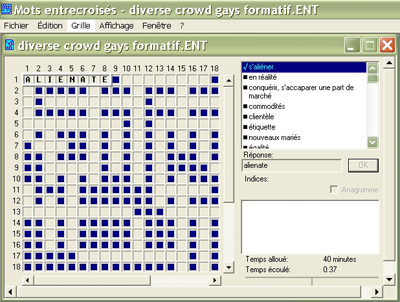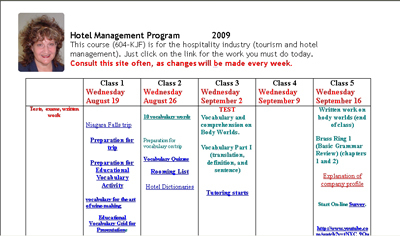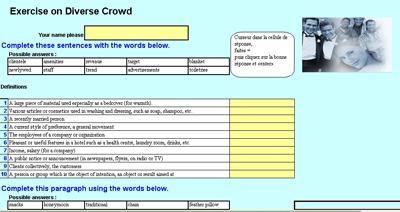When not all your students are even close to equal – Surviving Multi-level ESL Courses!
All francophone students take an English placement test upon entering college and then are placed in their first general English course according to their level. Although ESL teachers around the province rejoiced as some programs included English courses for specific purposes, their joy was short lived as invariably, these courses were not segregated according to English competency. Teachers faced classes filled with students whose English abilities varied from perfect bilingualism to a working vocabulary in double digits. IT has allowed me to come up with some solutions to this problem that I’m quite proud of.
Initial Solutions

A Crossword Puzzle from Crisscross Words.
By archiving information online, I set up a win-win situation where students felt motivated to learn at a pace that met their individual needs. The method was designed to ensure that students always had something to do and that students felt successful in their learning process. This method also allowed time for students to have a better rapport with me.
My initial plan was that students would start with a text to read and then answer comprehension questions as well as do a crossword puzzle as an exercise in acquisition of new vocabulary found in the text. I prepared the crosswords using the CCDMD software Crisscross Words 3.3. I also recorded my voice on MP3s so that students could listen to the pronunciation. The students continued by watching PowerPoint presentations on phonetics and grammar and then doing the exercises after each PowerPoint presentation. Students were to practice pronunciation while doing the exercises. I was expected to step back, answer questions, monitor the students’ work, give explanations as needed and provide opportunities for students to talk in small groups or with a partner. I was a bit zealous when I planned my courses and had to learn how to manage time in the lab. I organized way too much work for the students. They couldn’t possibly do it all in the lab!

A Recent Online Course Schedule
My Current Classes with Multi-level Groups
Five years ago, in these specific program courses such as tourism and hotel management, I asked students to be responsible for their learning by completing vocabulary worksheets, summary writing, and reflections after reading selected program-related readings. Since these groups are multilevel, some students felt that the readings were too easy or too difficult.
I felt that using technology would be one way to allow students to work at their own pace. The readings would be available on-line and students could move along as they wished. Students would have access to on-line dictionaries and ESL web-sites to work on the grammar necessary to complete certain tasks in class and would also be able to develop their listening skills through MP3s and selected programs.
I have enclosed an example of a reading, a related crossword, comprehension exercises and text questions for my hotel management students based on the story: Diverse Crowd.
Over a number of sessions, I’ve made modifications to my original plan which I think make courses run more smoothly. In the first week, I explain how the class is organised for the session. The plan for the entire 15 week course is on-line.

The ‘Diverse Crowd’ Text.
Current resources include the Intranet, dossiers, as well as course notes which serve as a tool for conversation workshops in class. The students are given 5 general themes related to their field of study and they have to discuss the theme. They are also given sample responses, and I generally do an example with them. My plan on the intranet has links to my e-mail, various dictionaries, the course outline and the software necessary to do the crosswords. There are links to various web-sites for writing a résumé, preparing for an interview and for interactive games.

The ‘Diverse Crowd’ Quiz on Excel.
I always start the course with an explanation of work which has to be done. Frequently there are oral presentations, written summaries, links for the day and then, the readings, crosswords, exercises and writings. I have enclosed an example of a reading, a related crossword, comprehension exercises and text questions for my hotel management students based on the story: Diverse Crowd. A vocabulary worksheet in Excel for the reading is also linked in the article. All readings are from authentic sources, related to the program, such as tourism or hotel management.
All the energy that I put into the planning of my courses has paid off!
After the reading, the students do the crossword associated to the reading. All difficult words in the text are underlined, and these are the words in the crossword. Then, the students have to complete various comprehension questions. The answers turn blue when they have clicked on the right answer, so they get immediate feedback. This is followed by discussion with a partner, and lastly they have to write a text such as different types of letters or reports based on their program. The students can access all activities from home, and work at their own pace using Netstorage which provides access to the college intranet. When they complete their work, they can continue to the next assignment. All assignments are handed in for error analysis and returned to the student for correction. There are assignments for each competence level, and standard evaluation grids which have been approved by the department are also prepared for each level. The students continue working autonomously for the entire hour.
The last two hours are given in class, and the time is spent doing conversation and presentations. The lab has allowed me to offer more time for speaking activities in class, and I have become a language facilitator. The students really appreciate the format of their courses and the different competence levels of the information make the multi-level composition of the class an interesting element rather than a pedagogical disaster. All the energy that I put into the planning of my courses has paid off!

